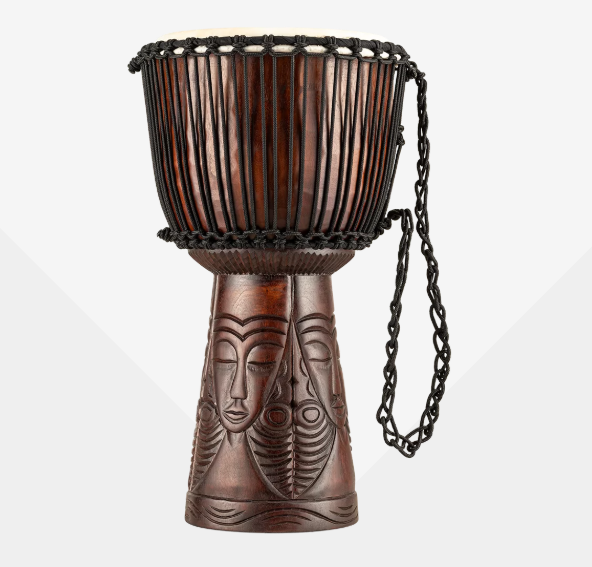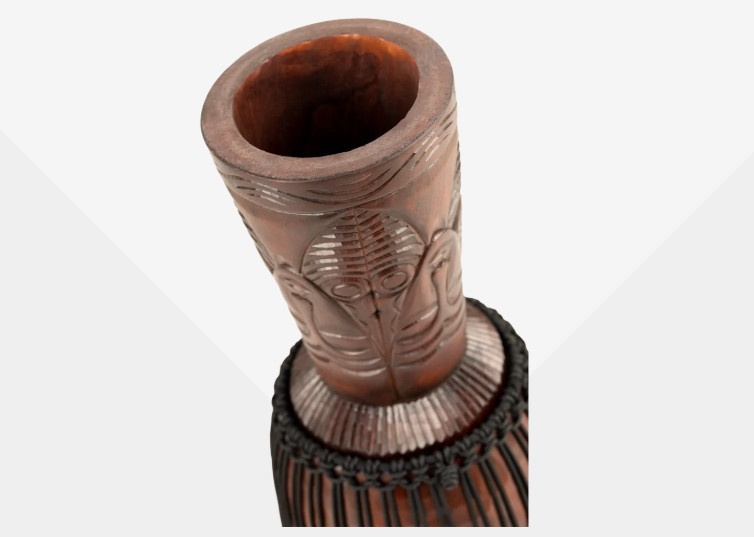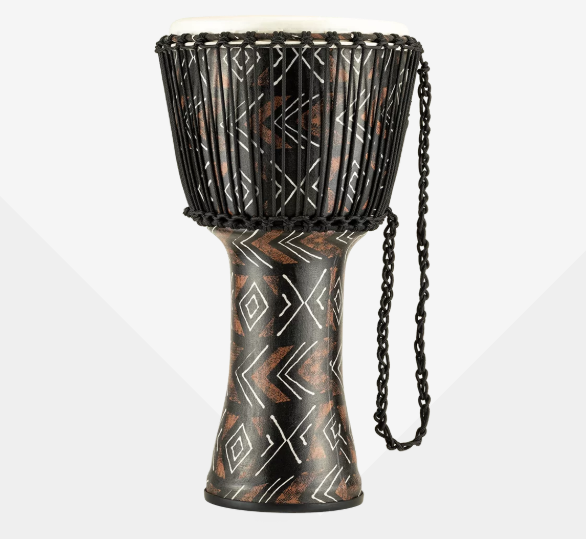After experiencing a few drum circles in the past few months, I was hooked. It’s not as if I haven’t experienced drumming circles before this year — after all, I’ve lived in Africa and traveled extensively through Africa, SE Asia, the Caribbean and Latin America.
As such, drums are far from new to me, but there was something about the Djembe drum experience vis a vis Shamanic and Congo drums that really drew me into them, as if wanting to have a direct one-on-one conversation with them.
The Djembe drums were saying: “create with me and have an intimate experience with us” and in doing so, I found that it more deeply connected me to others in the drumming group as well. Those who are in regular drumming circles know the feeling and resonance I’m talking about.

We had an opportunity to review a couple of drums from MEINL, who make African djembes in various sizes and two types: synthetic heads and natural heads, in this case goat heads for the purpose of this review.
Professional African Djembe: African Queen
We opted to review their 12 inch African Queen, which is carved from one solid piece of plantation grown Mahogany wood and comes with a goat head.

The MEINL Rope Tuned Travel Series Djembes are great drums for professionals as well as those who just want to enjoy an afternoon playing at home or with a drum circle. These patented djembes are ultra-lightweight (20% lighter than the company’s fiberglass djembes) which makes them easy to carry. We can vouch for that — they’re pretty lightweight considering the size of the 12 inch drum we received.
Rope-Tuned Travel Series Djeme: Kanga Sarong
We also decided to try the Rope-Tuned Travel Series Djembe with a Synthetic head but in a 10 inch size so we could experience both the difference in sizes of drums and the types of heads that they offer.

The ten inch Kanga Sarong
These drums come with 100% synthetic heads and shells, which make them perfect for playing outdoors. They too are ultra-lightweight making them a great choice for travelers.
The folks at MEINL use pre-stretched HTP nylon ropes, and there’s a non-slip rubber bottom which also serves to protect the drum from scratches. The drum itself produces sharp slaps and deep bass tones which are sprightier (one could say) compared to the warmer tones that the goat headed drums typically produce.
Understanding the Nuances
As noted above, their Professional African Djembes with the natural heads are expertly sewn from a solid piece of plantation grown Mahagony Wood, and fitted with a hand selected goat head. They use the traditional Mali Weave tuning system with high quality HTP rope.
When you browse through their website, you’ll notice that most of the djembe drums with natural goat heads use more down-to-earthcolors: muted browns and natural woods, all beautifully handcarved by African Artisans.
Alternatively, synthetic heads are made of plastic with a white painted coating — they have a slightly brighter and sharper tone. It is interesting to note that the drums with the synthetic heads tend to come in brighter colors — reds, oranges and yellows. When I asked about this, it turns out that is what their customers have preferred and so they responded in kind.
If you’re wondering what kind of head to go with, it’s really a personal decision. With synthetic heads, temperature changes are not an issue. That said, you get a more traditional sound that is warmer with the goat skinned heads. Because goat–skinned heads are natural, they will be more affected by temperature however, sometimes adversely so.
For example, the head can increase and expand in hotter and more humid temperatures whereas in colder and dry temperatures, it will shrink.
And, don’t make the mistake that newbies so often make. When you see the sizes of the drums listed on a website, note that these sizes are referring to the head size, not the height. For example, if you see a 12 inch drum, it refers to a 12 inch top and in our case, the 12 inch was around 24 inches tall whereas the ten inch heads are around 20 inches tall. This obviously impacts the sound, the weight and storage depending on where you plan to store it.
Tuning the Drum
There are apparently two types of tuning: rope tuned and key tuned, or you could say, mechanical tuned. You don’t want to tune the drum when the temperature is either hot and humid or when it’s colder and dry. If you‘re going through a lot of temperature changes, it is advised not to tune it (or to tune it when you‘re playing in that environment and to un-tune it when you‘re finished playing in that environment) because of the increased risk for tearing and head damage.
MEINL Percussion is an established brand and we can honestly say that we’re thrilled with the drums we were sent to test out and review. Bravo bravo!
In light of the Covid-19 lockdown, what a better time to pick up a new hobby than now? Why not get a drum and feel into your own heartbeat as it syncs up with the drum’s sound — it’s an empowering way to express yourself and connect to nature as well.
It’s also worth knowing about the MEINL Percussion Festival. Music lovers from many countries come to the MEINL headquarter in Gutenstetten to celebrate a festival of music together. From cajon, djembe, conga and timbales to singing bowls and hand pans – it’s all there.
Visit their website for more information on their drums, how to purchase them as well as the festival.

Renee Blodgett is the founder of We Blog the World. The site combines the magic of an online culture and travel magazine with a global blog network and has contributors from every continent in the world. Having lived in 10 countries and explored nearly 80, she is an avid traveler, and a lover, observer and participant in cultural diversity.
She is also the CEO and founder of Magic Sauce Media, a new media services consultancy focused on viral marketing, social media, branding, events and PR. For over 20 years, she has helped companies from 12 countries get traction in the market. Known for her global and organic approach to product and corporate launches, Renee practices what she pitches and as an active user of social media, she helps clients navigate digital waters from around the world. Renee has been blogging for over 16 years and regularly writes on her personal blog Down the Avenue, Huffington Post, BlogHer, We Blog the World and other sites. She was ranked #12 Social Media Influencer by Forbes Magazine and is listed as a new media influencer and game changer on various sites and books on the new media revolution. In 2013, she was listed as the 6th most influential woman in social media by Forbes Magazine on a Top 20 List.
Her passion for art, storytelling and photography led to the launch of Magic Sauce Photography, which is a visual extension of her writing, the result of which has led to producing six photo books: Galapagos Islands, London, South Africa, Rome, Urbanization and Ecuador.
Renee is also the co-founder of Traveling Geeks, an initiative that brings entrepreneurs, thought leaders, bloggers, creators, curators and influencers to other countries to share and learn from peers, governments, corporations, and the general public in order to educate, share, evaluate, and promote innovative technologies.








